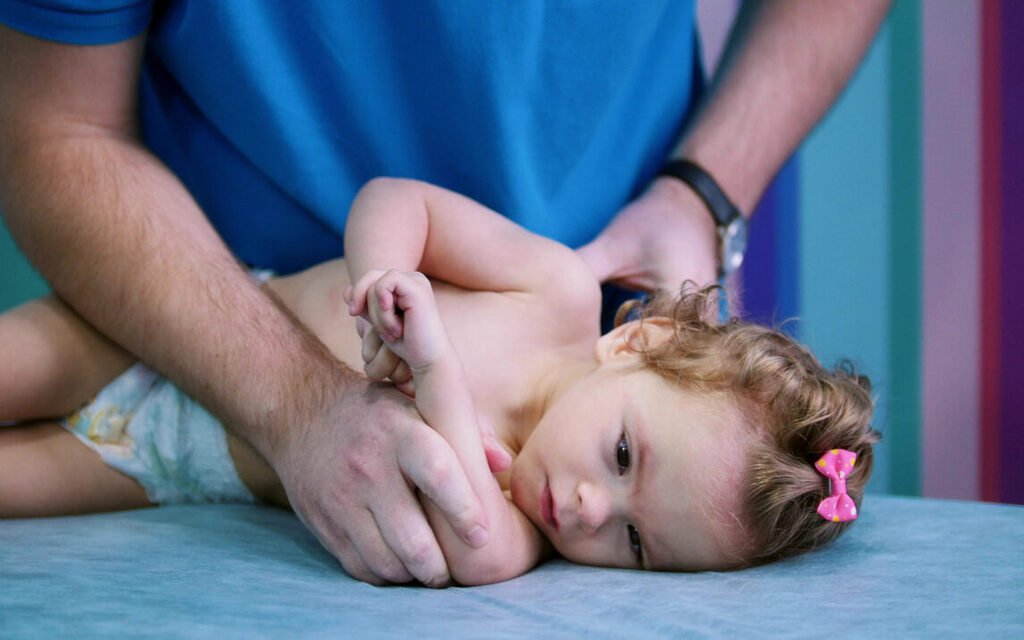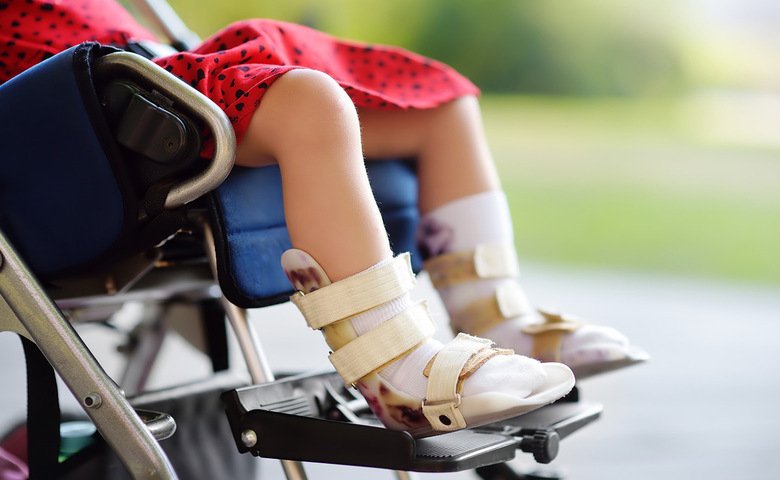A series of illnesses known as cerebral palsy (CP) disrupt muscular mobility and coordination. Cerebral palsy frequently also impairs vision, hearing, and feeling. “Cerebral” refers to something having to do with the brain. The term “palsy” refers to weakness or issues with mobility. People want to know more about cerebral palsy causes & treatment. Many people asked for the cerebral palsy causes & treatment.
The most frequent cause of motor impairments in children is cerebral palsy. The Centers for Disease Control and Prevention (CDC) estimate that 1 to 4 out of every 1,000 children around the world are impacted by it. Here we are exploring the cerebral palsy causes & treatment.
Table of Contents
Signs or Symptoms of Cerebral Palsy
From mild to severe, cerebral palsy symptoms might vary from person to person. Some cerebral palsy sufferers could find it challenging to sit and walk. Other cerebral palsy sufferers may struggle to hold objects.
As a kid matures and acquires motor abilities, the condition’s consequences may become more or less evident or restrictive. Additionally, they differ according to the region of the brain that was impacted.
Some of the more prevalent signs include:
- Delays in accomplishing motor milestones including rolling over, sitting up by themselves, or crawling
- Having trouble walking
- Muscle tone changes, such as being excessively floppy or too stiff
- Spasticity, also known as rigid muscles and heightened reflexes
- A loss of muscle coordination is known as ataxia.
- Trembling or uncontrollable motions
- Delayed speech development and speaking difficulties
- Excessive drooling and swallowing issues
- Reaching with one hand or favouring one side of the body
- Convulsions, intellectual impairments, and blindness are examples of neurological conditions
Most children with cerebral palsy have it from birth, however some may not exhibit symptoms for months or even years. According to the Eunice Kennedy Shriver National Institute of Child Health and Human Development, symptoms typically manifest a few months after birth.
Cerebral Palsy Causes
The precise cause of cerebral palsy is typically unknown.
Cerebral palsy can be brought on by abnormal brain development or damage to the developing brain. The area of the brain that regulates posture, coordination, and movement is damaged. The majority of the time, this brain damage happens before birth, although it can also happen during delivery or the first few years of life.
Other possible causes include:
- Head wounds brought on by a car crash, a fall, or child abuse
- Bleeding into the brain, or intracranial haemorrhage
- Illnesses of the brain such encephalitis and meningitis
- Embryonic illnesses such German measles (rubella) and herpes simplex
- Lack of oxygen to the brain during labour and delivery is known as asphyxia neonatorum.
- Gene changes that cause abnormal brain development
- Infant with severe jaundice
If you suspect that your kid may have cerebral palsy, see a doctor very once. Early detection and intervention are crucial.
Cerebral Palsy Risk Factors
Cerebral palsy is more common in infants due to a few variables. These consist of:
- Birth defects
- Low birth weight
- A poor Apgar score, which is a measurement of a newborn’s physical health,
- When a baby is born breech, their feet or buttocks emerge first.
- Rh incompatibility, which happens when a parent’s blood type and their unborn child’s blood type are incompatible,
- Exposure of the expectant parent to noxious substances, such as prescription pharmaceuticals harming the foetus, or illicit drug use
- Being a triplet or twin
Cerebral Palsy Types
According to the regions of the brain that are affected, cerebral palsy can have four different types of movement effects:
Spasticitiy
Dyskinesia
Ataxia
Hypotonia
Many people have a combination, and as a person ages and tries to perform new tasks like walk while maintaining balance, the apparent consequences can alter.
Spastic Cerebral Palsy
The most prevalent kind of cerebral palsy, which affects around 80% of those with the disorder, is spastic cerebral palsy. It creates tense muscles and heightened reflexes, making walking challenging.
Many persons with spastic cerebral palsy exhibit aberrant walking patterns, such as inadvertent knee crossing or scissor-like leg movements. Paralysis and muscle wasting may also be present.
The entire body may experience the symptoms, or just one side.
Dyskinetic Cerebral Palsy
Dyskinetic cerebral palsy patients have difficulty controlling their motions. Unusual, uncontrollable motions of the hands, legs, and arms are symptoms of the illness. Dyskinetic cerebral palsy can occasionally have an impact on the tongue and face.
The movements can be fast and quick or slow and writhing. The affected person may find it challenging to sit, walk, swallow, or speak due to the motions.
Ataxic Cerebral Palsy
The least prevalent form of cerebral palsy is ataxic. Voluntary muscular movements in people with ataxic cerebral palsy can appear clumsy, awkward, or jerky.
Those who suffer from this type of cerebral palsy frequently struggle with balance and coordination. They might struggle to walk and use their fine motor skills, which include writing and gripping objects.
Hypotonic Cerebral Palsy
Cerebral palsy with hypotonia results in underdeveloped muscular tone and excessively relaxed muscles. The arms and legs appear floppy and move quite freely, much like rag dolls.
Babies with this form of cerebral palsy may have difficulty breathing and have limited head control. They could have trouble sitting up straight as they age since their muscles are weaker. They may also possess or encounter:
- Speech difficulties and poor reflexes
- Irregularities in walking
Mixed Cerebral Palsy
Some persons have a mix of the symptoms associated with various forms of cerebral palsy. It is referred to as mixed cerebral palsy.
People with mixed cerebral palsy typically exhibit both spastic and dyskinetic cerebral palsy symptoms.
How is Cerebral Palsy Diagnosed
A thorough medical history, a physical examination that includes a thorough neurological examination, and an assessment of the symptoms are all steps a doctor will take to make the diagnosis of cerebral palsy.
Additional evaluations like the ones below could also be used:
Electroencephalogram (EEG): To assess brain electrical activity, an EEG is performed. When a patient exhibits symptoms of epilepsy, which is the main cause of seizures, a doctor might prescribe it.
MRI: An MRI creates precise images of the brain using strong magnets and radio waves. An MRI can be used by a medical expert to find abnormalities or injuries to the brain..
CT scan: Clear cross-sectional images of the brain are produced by a CT scan. It may also show signs of brain injury.
Ultrasound: A cranial ultrasound is a technique for obtaining basic images of a young infant’s brain using high-frequency sound waves. It is reasonably quick and affordable.
Blood tests: In order to rule out further potential illnesses, such as bleeding disorders, a healthcare expert may collect and test a sample of blood.
When cerebral palsy is confirmed, a doctor could recommend that you or your child see a specialist who can perform tests for neurological problems that are frequently present with the disorder. These exams could reveal:
- Visual problems like blurry vision in one or both of the eyes
- Deafness
- Speech difficulties
- Mental health issues
- Movement disorders
Cerebral Palsy in Adults
Those who have cerebral palsy may experience difficulties such as:
- Communication problems, including speech and language issues
- Spinal conditions including kyphosis (hunchback), lordosis (swayback), and scoliosis
- Osteoarthritis
- Contractures, which happen when muscles become stuck in uncomfortable postures
- Bones that have osteopenia, or low bone density, may be more brittle.
- Dental issues
- Incontinence
Cerebral Palsy Treatment

Treatment aims to lessen restrictions and avoid problems. Treatment options include surgery, medicine, and supportive devices.
Assistive aids
Assistive aids include:
- Eyeglasses
- Hearing aids
- Walking aids
- Body braces
- Wheelchairs
Medications
Drugs that relax muscles are frequently used to alleviate the effects of spasticity. Muscle relaxation aids in easing the pain caused by muscle spasms.
Your doctor might prescribe:
- Baclofen
- Dantrolene (Dantrium)
- Diazepam (Valium)
- Tizanidine (Zanaflex)
Your doctor may also recommend intrathecal baclofen therapy (Gablofen, Lioresal), which delivers the medication through an implanted pump, or local injections of botulinum toxin type A (Botox).
Surgery
It is possible to increase mobility and relieve discomfort through orthopaedic surgery. It could also be required to treat bone abnormalities brought on by spasticity or to loosen up tense muscles.
As a last option, selective dorsal rhizotomy (SDR) may be suggested to lessen persistent pain or stiffness. It entails severing nerves close to the spinal column’s base.
Other treatment
The following are additional forms of care for cerebral palsy:
- Speech therapy
- Occupational therapy
- Physical therapy
- Recreational therapy
- Counseling or psychotherapy
- Social services consultations
Research on stem cell therapy as a potential cerebral palsy cure is still in its early phases, even though experts are looking at it. It might be most useful for assisting with the improvement of motor symptoms.
Prevention of Cerebral Palsy
Most of the factors that contribute to cerebral palsy cannot always be avoided. You can, however, take certain preventive steps to reduce difficulties if you are pregnant or intend to get pregnant.
It’s crucial to get immunized against diseases like German measles (rubella), which can result in foetal brain damage.
It is essential to get quality prenatal care. Premature birth, low birth weight, and infections can be avoided throughout pregnancy by keeping frequent appointments with your doctor.
Cerebral Palsy Life Expectancy
Life expectancy for someone with cerebral palsy relies on a number of factors that are unique to each individual. With the proper care and treatment, the majority of children with cerebral palsy will enjoy long, fulfilling lives.
One of a parent’s top concerns for a child is their life duration. The majority of people with Cerebral Palsy live healthy lives, even though life expectancy depends on a variety of circumstances, provided that life-threatening associated diseases are managed and that appropriate medical care and lifestyle supports are put in place. In general, eight variables have been found to have an impact on a person with cerebral palsy’s life expectancy.
It’s crucial to understand that cerebral palsy does not get worse with time. However, cerebral palsy’s associated medical conditions run the risk of getting worse and creating consequences.
For instance, the following cerebral palsy-related conditions may worsen with time and affect the patient’s quality of life:
- Seizures
- Spasticity and trouble moving
- Issues with vision and hearing
- Difficulties with cognition and behavior
- Joint and spinal issues
- Reflux in the stomach and constipation
- Oral motor difficulties
- Respiratory difficulties
These problems don’t necessarily mean that your child won’t live as long. It does, however, imply that as a parent, you must exercise diligence in seeking medical attention and continuing your therapy.
Conclusion:
Cerebral palsy has no known treatment, however some of its consequences can frequently be controlled, and many complications can be avoided or postponed. Individuals receive a variety of treatments, each with a different focus. While some cerebral palsy sufferers might not require much assistance, others would require intensive, long-term care for their symptoms. Regardless of the severity of the condition, treatment can help people with cerebral palsy live better lives by improving their communication and motor skills.
Frequently Asked Questions
1. How long does cerebral palsy recovery take?
A youngster who has CP surgery will require physical therapy and a lengthy healing period. The length of therapy will vary depending on the type of surgery. Relearning how to walk or use certain muscles may be necessary for a toddler. Although this takes time, there are frequently noticeable effects that continue for many years.
2. Is living with cerebral palsy challenging?
Fortunately, it is believed that CP has no effect on lifespan. The life expectancy of adults with CP is on par with that of the general population. Parents may be surprised to learn their child has cerebral palsy, but the disease is manageable with the right care and treatment.
3. Has cerebral palsy been linked to gender?
Boys are more likely than girls to have CP, and black children are more likely to have it than white children. The majority of children with CP (about 75%–85%) have spastic CP.
4. Can someone who has cerebral palsy marry?
When a young person with cerebral palsy matures into an adult, the dating scene could appear to be as full of thorns as a rose. The good news is that people with Cerebral Palsy who are looking for relationships do more than just date; they also discover love, build families, and have happy, fulfilling lives.
5. Is cerebral palsy temporary or permanent?
There is no known treatment for cerebral palsy, which is a chronic condition. Cerebral palsy does not, however, advance, meaning that it does not get worse with time. Some of the underlying issues can get worse. Cerebral palsy cannot be cured, however treatments can help with symptoms, daily life, and quality of life.
6. What are the signs of cerebral palsy and how is it treated?
Movement, coordination, and developmental issues are the main signs and symptoms of cerebral palsy. Possible symptoms in a young person include: delayed attainment of developmental milestones, such as failing to sit by 8 months or walk by 18 months. appearing excessively floppy or rigid (hypotonia)
7. What are the signs of cerebral palsy and what causes it?
Due to a brain damage, cerebral palsy is a condition that impairs movement in the body. The injury does not get worse over time and can occur before, during, or after birth. Movement and posture of the body are impacted by brain injury. Involuntary muscle motions or floppy or stiff muscles are frequent symptoms.
8. What is the course of cerebral palsy treatment?
Physical therapy and rehabilitation are common forms of treatment for cerebral palsy. These treatments are typically started in the first few years of life or soon after a kid with cerebral palsy is diagnosed. One of the key components of treatment is physical therapy.
9. What factors lead to cerebral palsy?
Damage to or abnormal development in the areas of the brain that control movement is what leads to cerebral palsy. These occurrences can take place in the first few years of life, when the brain is still developing, or just before, during, or right after birth. The precise cause of cerebral palsy is frequently unknown.
10. What is the world’s top therapy for cerebral palsy?
One of the top diagnostic and treatment facilities for kids with cerebral palsy (CP) and spasticity is located at Boston Children’s Hospital’s Cerebral Palsy and Spasticity Centre.
11. How treatable is cerebral palsy?
Although there is no known treatment for CP, it is possible to make life better for those who have it. Starting a treatment program as soon as feasible is crucial.
12. What are 3 early signs of cerebral palsy?
- Developmental delays. The child takes a while to accomplish developmental milestones like rolling over, sitting, crawling, and walking.
- Abnormal muscle tone. Body components are too rigid or floppy.
- unnatural posture
13. What is the course of action for spasticity in cerebral palsy?
The most common therapies for cerebral palsy spasticity and associated issues are oral medications, Botox injections, baclofen infusions, orthopaedic surgery, selective dorsal rhizotomy surgery, physical therapy, and braces.
14. How is cerebral palsy preventable?
- Ensuring that your child has received vaccinations for all prevalent baby illnesses.
- Utilising the ideal car seat for the size and weight of your child.
- Putting a bed rail on a cot.
- Never leave your child unsupervised on high surfaces like countertops.
- Never shake a child.
15. What stages of cerebral palsy are there?
Mild, Moderate, and Severe levels of severity are frequently used to categorize cerebral palsy. These are generalizations without a clear set of standards. Even when medical professionals agree on the severity level, the classification offers little detailed information, particularly when compared to other methods of classification.
16. Can cerebral palsy be cured by brain surgery?
Surgery can be a good way to treat cerebral palsy symptoms, but it won’t make the condition go away. It’s crucial to consult a healthcare professional to assess your child’s symptoms and decide whether surgery is required.
17. What percentage of cerebral palsy patients recover?
Average survival times for many kids with milder forms of cerebral palsy are comparable to those of the general population. Children with mild cerebral palsy have a 99% chance of living to the age of 20, whereas children with severe cerebral palsy have a 40% chance.
18. Is cerebral palsy temporary or permanent?
There is no known causes & treatment for cerebral palsy, which is a chronic condition. Cerebral palsy does not, however, advance, meaning that it does not get worse with time. Some of the underlying issues can get worse. Cerebral palsy cannot be cured, however treatments can help with symptoms, daily life, and quality of life.
19. How long does cerebral palsy last?
Cerebral palsy causes & treatment has no known. However, cerebral palsy does not get worse over time way many other significant medical problems do. This is due to the fact that the illness is brought on by a single brain damage.
20. What is the most typical age for cerebral palsy?
CP is frequently identified in the first or second year following birth. It can be challenging to diagnose a young child with modest symptoms until they are a few years old.
21. If you have cerebral palsy, can you walk?
Yes, a lot of cerebral palsy sufferers can walk. In reality, more than half of all people with cerebral palsy are able to walk unassisted without the use of crutches or walkers. Multiple bodily parts can be impacted by cerebral palsy, which can range in severity from moderate to severe.
22. What is mild cerebral palsy?
Mild brain damage to the developing brain results in motor limitations known as mild cerebral palsy. Motor impairments may go unnoticed in the early years of life because the harm is not as severe. However, motor deficits may become more obvious as children with moderate cerebral palsy mature.
23. What is the ideal method of treating spasticity?
Casting or bracing: avoids uncontrollable spasms and lessens muscle tightness.
Oral drugs: Oral medications, like physical or occupational therapy, are used in conjunction with other treatments or medications. Only when symptoms interfere with daily activities or sleep are oral drugs utilized.
24. Which part of the brain is damaged in cerebral palsy?
A collection of conditions known as cerebral palsy (CP) affect posture, balance, and mobility. The cerebral motor cortex is impacted by CP. This area of the brain controls how muscles move. Actually, the word “cerebral” in the name means “related to the brain.”
25. What time frame is critical for cerebral palsy?
With cerebral palsy causes & treatment, it is important to be aware of important gross motor milestones such head control at 2 months, rolling at 4 months, sitting at 6 months, and walking at 1 year.
26. Can those who have cerebral palsy speak?
Some cerebral palsy patients may not be able to make any noises, while others may be able to make sounds but struggle to control their movement well enough to speak in a way that is understandable to others. One in four cerebral palsy sufferers are mute.
27. Can medication be used to treat cerebral palsy?
Medication, therapy, and surgery are the main cerebral palsy treatment modalities. In order to live a long, healthy life, cerebral palsy treatment aims to manage symptoms, ease pain, and maximize independence. Each person’s cerebral palsy causes & treatment is customized to target and address their unique symptoms.
28. Is cerebral palsy an issue with the nervous system?
A range of illnesses known as cerebral palsy (CP) can affect the brain. This has an impact on the nervous system’s ability to control movement, learning, hearing, vision, and thought. CP can be spastic, dyskinetic, ataxic, hypotonic, or mixed, among other variations.
29. Can someone with cerebral palsy lead a complete life?
Children with cerebral palsy can typically expect to live between 30 and 70 years. Most people who live the longest tend to be more mobile, have better medical treatment and adaptive equipment, and are more independent and autonomous. Cerebral palsy causes & treatment has no known.
30. Can someone who has cerebral palsy give birth?
While women with cerebral palsy may have a higher rate of caesarean deliveries, there is no conclusive evidence that they are at an increased risk for other birth issues such miscarriages, abnormalities, or pregnancy-induced hypertension. Cerebral palsy has no effect on fertility.
31. Can you fully recover from cerebral palsy?
Although there is no known cerebral palsy causes & treatment, many people can benefit from supportive therapies, drugs, and surgery to enhance their motor skills and social interaction.
Also Read: Cardiovascular Disease Causes & Treatment
Image credit: Yandex.com















